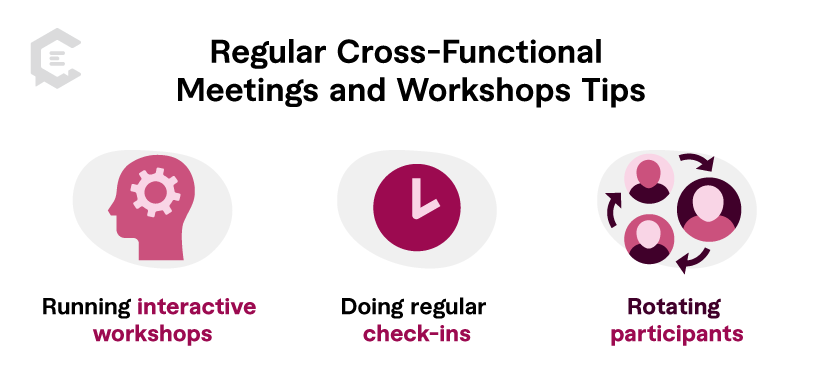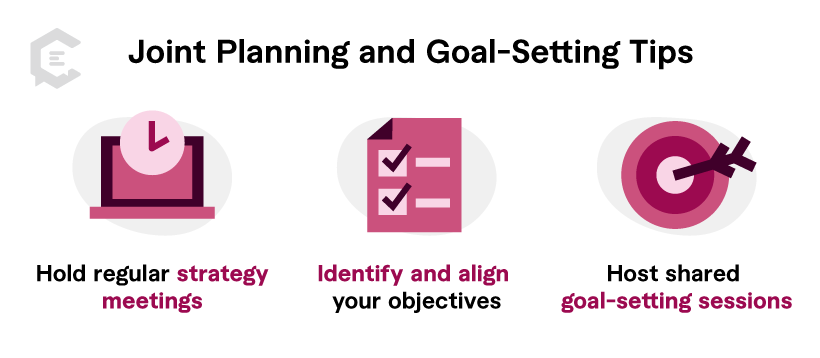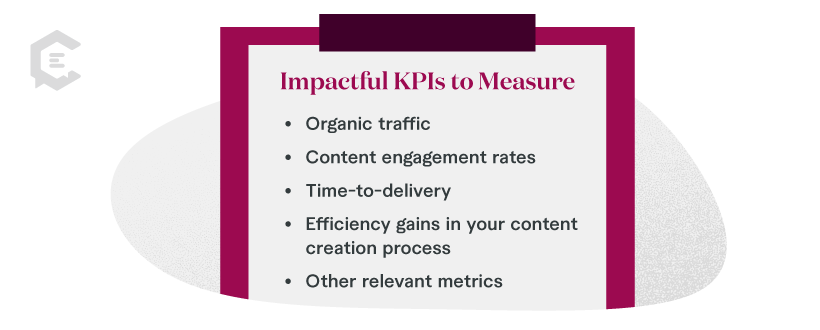Team silos can hurt the efficiency of your content operation, BIG TIME.
When your teams operate in isolated silos, various disadvantages arise. You experience:
- Communication breakdowns
- Bottlenecks
- Goal misalignment
- Duplicate output
- And more
The key to smashing these silos is to implement cross-functional collaboration across your teams.
Continue reading to discover the importance of cross-functional collaboration in content operations, strategies to ensure effective team communication and collaboration across departments, and proven tips to bolster your content operation.
The Power of Cross-Functional Collaboration
Cross-functional collaboration can transform your content operations, giving it a more dynamic and integrated framework.
Involving various departments in your content operations can help with the following.
Enhancing content relevance and quality
Working with people from various expertise and departments provides opportunities to gain diverse perspectives you can weave into your content creation process.
The diversity can unearth unique insights, skill sets, and fresh ideas to ensure your content reflects a broader and more in-depth understanding of your market and audience.
A more holistic approach allows for multidimensional input, making your content more engaging, relatable, and well-rounded and, in turn, enhancing your content’s quality, relevance, and effectiveness.
Streamlining content production
Cross-functional collaboration brings expertise, perspectives, and skills from individual departments together, including the third-party companies providing you with content writing services.
It can reduce bottlenecks and allow for seamless content optimization and creation.
Collaborative teams can draw from a more extensive knowledge and creativity pool, streamlining brainstorming ideas crucial to efficient content production.
Cross-functional collaboration facilitates better coordination and communication, reducing misunderstandings and content production delays.
Bridging the Gap: Strategies for Cross-Departmental Unity
Consider the points below to foster team collaboration between various departments.
Some of the best regular cross-functional meetings and workshop tips are:
- Running interactive workshops
- Doing regular check-ins
- Rotating participants
Communication channels and tools
Leverage the right technologies and channels to ensure seamless inter-departmental communication, such as:
- Project management tools. Use project management tools such as Asana, Trello, and ClickUp to manage and create visual overviews of team responsibilities, tasks, and deadlines. They can streamline task management, promote transparency, and keep everyone on track. It lets your teams see how their work contributes to your content production process.
- Centralized communication channel. Opt for centralized hubs that allow teams from various departments to share updates and communicate easily. Microsoft Teams, Slack, and similar platforms provide a space for real-time quick exchanges, ensuring everyone stays on the same page and reducing delays.
- Document sharing and collaboration hubs. Use cloud-based document-sharing tools such as Microsoft 365 and Google Workspace for real-time document access and collaboration, ensuring seamless content management. The platforms give your teams easy access to the latest information, reducing potential errors and promoting a more centralized approach.
Joint planning and goal-setting
Use these tips to align your objectives and strategies across departments:
- Hold regular strategy meetings. Conduct strategy meetings regularly to allow your teams to share their insights, discuss their strategies, and spot potential synergies. The regular meetings help ensure your strategies are aligned.
- Identify and align your objectives. Determine and align each team’s objectives with your overarching content operation efficiency goals. Doing so helps your departments understand their roles in the overall picture, ensuring coordinated efforts for success.
- Host shared goal-setting sessions. Bring representatives from various departments and run shared goal-setting sessions to start your joint planning. Get input from everyone to foster a commitment to and ownership of common content operations objectives.
Regular cross-functional meetings and workshops
Encourage ongoing dialogue and idea exchange by:
Running interactive workshops
Host workshops that allow your teams to collaborate on common goals or specific projects. The workshops are excellent for encouraging problem-solving and idea exchange across departments.
For example, you can hold a workshop where your marketing, design, and development team collaborate on a new product launch campaign. The workshop can include brainstorming sessions to come up with creative content ideas and collaborative design exercises to conceptualize product and marketing material visuals.
Doing regular check-ins
Ensure continuous communication by scheduling regular cross-functional meetings. The sessions allow various department teams to share ideas, challenges, and updates, contributing to the overall efficiency of your content operations.
Rotating participants
Rotate various department team members in workshops and meetings. Doing so ensures consistent representation of different perspectives, allowing everyone a more comprehensive understanding of each department’s role in improving content operation efficiency.
Overcoming Challenges in Cross-Functional Collaboration
To make your cross-functional collaboration a success, there are challenges you need to overcome.
The points below include some of the challenges you’ll face and ideas to address them.
Managing diverse opinions and expertise
Leverage these strategies to balance various perspectives and skill sets for more cohesive and efficient content operations.
- Assign specific roles and responsibilities based on your team members’ expertise when working on content projects. Designating functions and roles helps avoid confusion, streamlines collaboration, and ensures everyone knows what they contribute.
- Create constructive feedback channels as a space to address various opinions. Encourage team members from separate departments to give feedback on your content strategies and share their ideas. It allows everyone to share constructive criticism that you can learn from to improve your content operation’s efficiency and effectiveness.
- Foster a work culture that promotes collaboration. It can encourage team members to share and appreciate diverse skills and perspectives. Highlight how each member contributes to achieving your content efficiency and operations goals.
- Highlight the diversity of expertise across your teams. Acknowledge unique contributions to your content operations, whether it’s a data-based insight or a new approach to storytelling. Doing so fosters a positive collaborative environment while helping you weave in fresh and unique ideas to optimize your content workflows.
Measuring the impact of collaboration
One of the common challenges in cross-functional collaboration is knowing what’s working and what needs improvement.
The solution? Set metrics and Key Performance Indicators (KPIs) to assess the effectiveness of your collaborative efforts in streamlining your content operations.
For instance, identify the KPIs that align with your objectives.
Some KPIs worth considering are:
- Organic traffic
- Content engagement rates
- Time-to-delivery
- Efficiency gains in your content creation process
- Other relevant metrics
Remember to pick measurable indicators directly reflecting your cross-functional collaboration’s impact.
Before implementing your collaborative content strategies, you must also establish baseline metrics to determine your starting point.
Doing so gives you a basis for comparison, allowing you to quantify your collaborative efforts’ impact on your content operations efficiency over time.
Case Studies of Successful Cross-Functional Content Operations
Below are a few real-life examples of businesses that have optimized content operations through collaboration.
- Adobe Max 2023 | The Creativity Conference. Adobe leverages creative cross-collaboration to create compelling digital assets and stories and solve challenges in handling projects. The Adobe Max team ensures inclusivity, encourages fluid responsibilities and roles, embraces experimentation, and uses collaborative technology for effective and efficient cross-collaboration and content production.
- Netflix facilitates collaboration between its data science and engineering teams to optimize its content delivery and service. To address the crucial data science problems in the content delivery space, Netflix built a new team of data scientists and engineers to focus on Content Delivery Network Science and Algorithms to optimize content quality and delivery.
Optimize Content Efficiency with Seamless Team Collaboration
The synergy among your diverse teams is critical for ensuring content operations efficiency, innovation, and success.
Breaking down silos and building a culture that fosters shared objectives and open communication can turn individual efforts into cohesive strategies and output, resulting in seamless content operations.
If you’re struggling with your content marketing initiatives and you’re looking for a reliable content agency to help
Develop a strong content strategy that’s founded on efficient workflows by collaborating with top-notch content agencies like ClearVoice. Talk to an expert content specialist and see how we can help.










